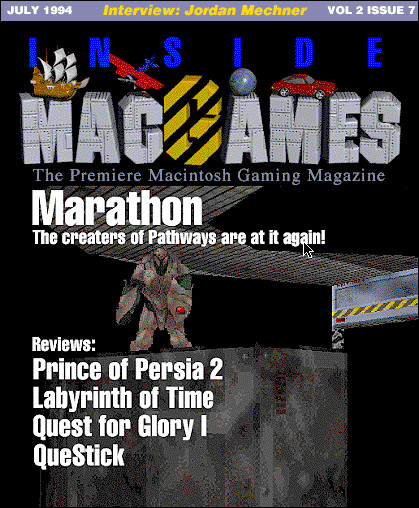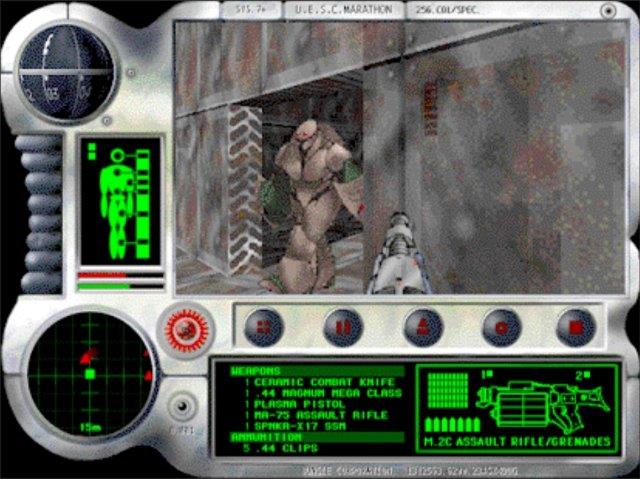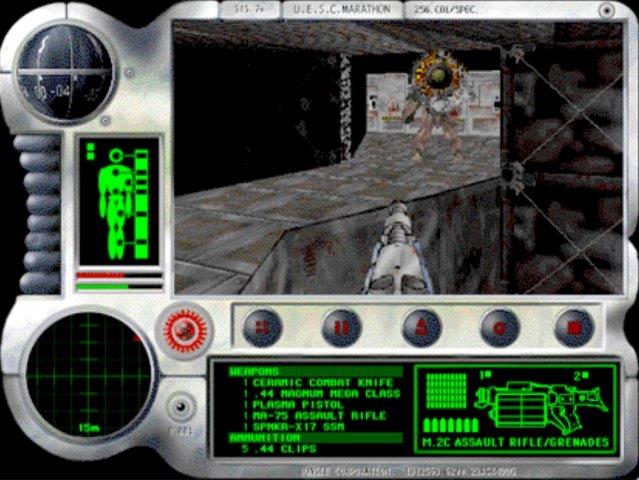

Home
Season One
About
—
Games
Daily Updates
Go Back
Daily Update - June 5th, 2025
June 5th, 2025
Sneak Peek: Marathon
[by Tuncer Deniz, IMG July '94]

NOTE: Screen shots and information presented in this article are based on a pre-release version of Marathon and are subject to change before final release. This article is not a review.

Last year, Bungie Software released a revolutionary 3-D game
called Pathways Into Darkness. It was the first
texture-mapping game on the Macintosh and it went on to become
an extremely successful title. In fact, it won Inside Mac
Games' Adventure Game of the Year, the Macworld Game Hall of
Fame award, and the MacUser 100.
Now, almost a year later, Bungie is working on a follow up to
Pathways Into Darkness entitled Marathon. Although it's not a
sequel, the new game features some of the same 3-D real-time
graphics featured in Pathways Into Darkness, but, of course,
with some rather massive (and impressive) improvements.
Marathon features a newer, more sophisticated and faster
graphics engine, better looking graphics, enhanced artificial
intelligence, a unique and intuitive interface, networking,
PowerPC support, and more.
The Plot Thickens. The game begins on a space
ship called the Marathon. Unlike other ships, the Marathon is
unique in that it once used to be a small Mars moon called
Deimos. Years ago the moon (very small in size) was mined,
hollowed out, and turned into a space ship (ah, don't ask me
how). After traveling hundreds of years to a planet believed
to be habitable by humans, the colonists on the Marathon land
on the planet and begin to terreform it. A few years into the
operation, the colonists find a strange, metallic sphere
containing some strange hieroglyphics near the colony. After
some low-level studies are conducted on the object on the
planet, the colonists send the sphere to the Marathon for
further testing by the scientists on the ship (using more
sophisticated equipment found only on the mother ship).
A few hours after the sphere arrives on the Marathon, the
scientists send a message back to the planet saying the sphere
is a capacitor holding a huge amount of energy and are in need
of an electrician for further studies. This is where you come
in. You, the electrical specialist, are instructed to take a
shuttle from the planet to the Marathon to do further tests on
the object. When you land and disembark from your shuttle onto
the Marathon, you realize things have gone terribly wrong.
Strange aliens have somehow come on the ship and killed
everyone on board and you'll be next if you don't do
something......quick.

Marathons interface includes a compass, motion detector, weapon info, and more.
Not Pathways: Part 2. By now you've probably
guessed what you have to do...find a weapon fast and start
killing bad guys like in Pathways! Carnage! Yea, well, that's
not all true this time. The wizards at Bungle have learned
quite a bit from their previous games and have added new
elements to the storyline to make the game more dynamic and
less frustrating than Pathways Into Darkness. Although it'll
still be a pretty hard game, the authors of the game promise
you won't (hopefully) get stuck on a level and get so
frustrated you have to call Bungie's technical support line.
As the game evolves, you'll find yourself going through the
various levels on the ship and will eventually find your way
to the alien colony on the planet for your final confrontation
with the bad guys..
In the game you'll not only have to use your quick reflexes
but also combat tactics like ambushes and stealth to out smart
and out-fight your enemy. In some cases, it'll be futile to
suddenly go into a room with 20 aliens and start shooting.
You'll have to somehow either disguise yourself as an alien or
use another form of stealth to get by them. The aliens in
Marathon are also now smarter (but they also have a tendency
to be dummer). For example, if you are hiding behind a wall
next to a door and the door opens, there's a good chance the
alien will simply walk right by you and not even notice you.
In fact, if you are quiet enough and keep a distance, you'll
be able to follow an alien around without being noticed.
In Pathways, the monsters would only come at you depending on
your proximity to them on a level. In Marathon, the aliens
move about a level independent of what you do. For example, if
you stay put in one hidden area the whole time, you'll see the
aliens move about the level going about their business. Of
course, if you start causing a scene like shooting or
fighting, the aliens will instinctively come to the "check out
noise."

The auto-mapping feature in Marathon comes in handy should you get lost.
The Graphics, Interface, and Cyberspace. The
new graphics engine (completely re-written about 3 times for
Marathon) runs about twice as fast as the one in Pathways Into
Darkness. In addition to moving forward, backward and sideways
(like in Pathways), you'll also be able to look up and down
(something you can't do in Pathways or DOOM for that matter),
climb up and down stairs, jump, and make other movements.
Marathon will also have textured floors and ceilings and other
complex structures (like spiral staircases). Even though the
graphics engine is twice as fast as that of the one in
Pathways, the added complexity of the graphics will make the
game extremely slow on slower Macs (Ilsi and below). However,
the good news is that the game will run extremely fast on 040
machines and blazingly fast on PowerPC based Macs.
One of the obvious drawbacks in Pathways Into Darkness was the
repetitiveness of the graphics in the game. The walls, doors,
and monsters all basically looked the same on all the levels.
In Marathon, the graphics are rich and varied. Different
levels on the ship and planet will be completely different
than the ones before.
The interface in Pathways was also awkward in that you had to
use your mouse to select potions, ammo, etc. Marathon fixes
this problem with a new, slick interface. On the left of the
main view screen is a rotating compass which is used to show
the heading of your movement. On the bottom left of the screen
is a motion detector (inspired by the one found in the movie
Aliens). You'll be able to use the motion detector to find the
distance, speed, and heading of your opponent(s).
The game will also feature an enhanced auto-mapping feature.
In auto-map mode, you'll be able to navigate throughout a
level in real-time. Areas previously undiscovered will be
drawn when moving into a certain area. Once you've walked
through a whole level, the entire level will be mapped out.
Quite a handy feature if you should get lost or need to return
to another area quickly.
Another twist to the game is the addition of cyberspace. In
Marathon, cyberspace is essentially the computer's
interpretation of the real world. In the game you'll be able
to find cyberspace portals that will let you go into
cyberspace. Once in cyberspace, you'll find the cyberspace
world to be exactly like the real world you were just in but
with some physical changes like more objects, corridors,
doors, and walls than in the real world. For example, imagine
you came to a door that was locked and had no way to get in.
In Marathon, you'll be able to jack into cyberspace and find a
way to open the door in cyberspace through the use of
additional tools, rooms, etc. If you should get killed in
cyberspace or decide to return to the real world, you simply
return to the real world unharmed and in the same place you
jacked into cyberspace.

Incoming! Now would be the perfect time to jump off that ledge.
Network Play. One of the more exciting new
features in Marathon will be the addition of network play.
Think of the network play as the arcade part of Marathon.
In network play, the player will be able to play against a
number of human opponents across a network (or ARA). Gameplay
on a network will be set up so a player has to engage human
opponents on the network on a specially created network level
(unlike the ones found in the adventure part of the game).
You'll be able to form teams (for example, reds against blues)
and you'll also be able to assign aliens to a certain team to
fight on your side. The games will be, for example, in the
following forms: every man for himself, whomever gets the most
kills in 10 minutes wins, capture the flag, and on and on.
Mood Rellik? It seems once again the guru's
at Bungie are taking another giant step forward in the Mac
game industry with Marathon as they did one year ago with
Pathways Into Darkness. Combined with excellent graphics,
exciting gameplay, networking, a super slick interface and
other surprising innovations, Marathon will no doubt be one of
the hottest titles this year.
But I almost positive that 99 percent of the people who read
this preview will ask, "Uh, huh, huh....dude, how does it
compare to DOOM?" Well, if you think I'm going to compare and
contrast both products you're absolutely wrong. Let's face it,
DOOM is not on the Mac so how can you make a comparison? Or
should we even try to make a comparison? Would it be fair to
make a comparison between a PC product and a Mac product?
Absolutely not! Mac gamers should be thankful that Bungie has
made a commitment to bring top-notch entertainment to the Mac
and should support the efforts (provided of course if the
final shipping product is up to our expectations) of
publishers who PUBLISH Macintosh game titles. Yea, ok, sorry,
enough lecturing <grin>.
Although Marathon is still in the late development stages, the
programmers are putting in 24 hour shifts (OK, 23 hours if you
count the hour or so they waste playing Street Fighter 2 Turbo
on their SNES) to complete Marathon. Look for it in August, or
September.
From Inside Mac Games, July 1994 Issue.
- Twitch Stream - YouTube - Patreon - Ko-Fi - Backloggd -